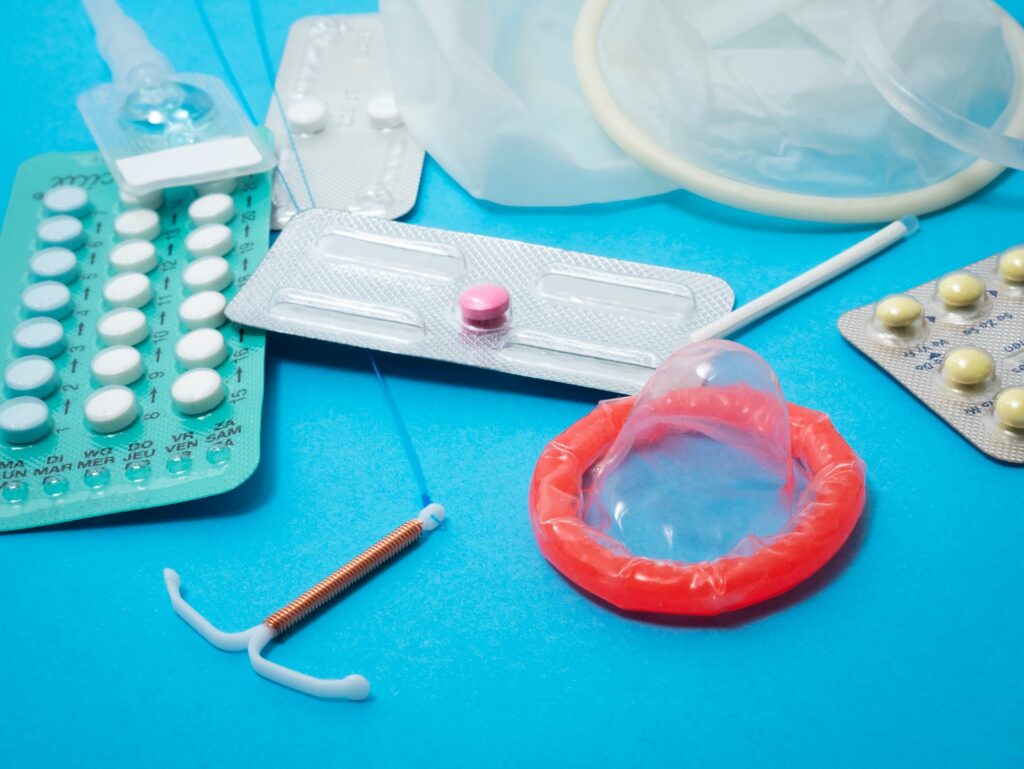April is STI/STD Awareness Month So Here’s What You Need To Know About Having Healthy Sex
April is STD/STI (Sexually Transmitted Disease/Sexually Transmitted Infection) Awareness month. Taking a few minutes to learn about STIs/STDs probably isn’t on today’s to-do list, or even on your sex bucket list, but it’s necessary. Why? Because cases of 3 common STIs have reached all-time highs in 2019. Because if you’re having sex or even intimate contact, you need to be tested. Because condoms break and sometimes don’t offer protection. Because knowledge is power. Read and share this article to empower yourself, your sexual partner(s), your friends, and your family so you can be and stay healthy.
Note: You might call them STDs, Sexually Transmitted Diseases. ALMOST the same thing: Scientifically speaking, the difference between diseases and infections is that diseases present with symptoms and infections typically do not. And most STIs do not have symptoms. The only way to diagnose an STI is to screen for it.
Why I Got Tested For STDs (And You Should Too)
A few days ago I had scheduled some routine tests like a mammogram and shingles vaccine, and I figured I may as well get tested for STIs since I am beginning a new romantic relationship and I want to be ready when I’m ready! I have no concerns that I have any STIs, but that’s not why I’m getting tested. I’m really getting tested so I can ask my new romantic interest for his test results, like “Hey here’s mine, show me yours.”
And because I needed to know which tests to get (there are many!), and therefore ask my love/sex interest to get, I did some research and had a long conversation with my provider, Dr. Stotz Thoda, DO, a traveling doctor for our West Coast region of Mosaic Medical (a great medical group, by the way, that accepts insurance as well as offers sliding scale payment if you need to pay out of pocket). This Doc has been around the block! And wow! I learned a few things! (And the nice nurse gave me a swag bag of about 60 condoms!)
What I Learned About STIs (There’s A Lot to Know!)

First, I learned that the Standard Panel for STIs (even as recommended by the US Centers for Disease Control, only includes testing for four infections: chlamydia, gonorrhea, syphilis, and HIV. But there are actually nine common STIs! WTW? Four is a good start, but why not test for more since you’re already at the clinic? You’ll need to share samples of blood and urine and a swab to cover them all, which I highly recommend.
(DISCLAIMER: This article is not intended to be a substitute for professional medical advice, diagnosis, or treatment. Always seek the advice of a qualified health provider with any questions you may have regarding a medical condition.)
With a little research, I learned that “We have an STD crisis in the US because prevention programs were sold short for years,” says David Harvey, executive director of the National Coalition of STD Directors. STI rates are so alarming in the United States that the Department of Health and Human Services has developed a STI Federal Action Plan to be implemented in 2020. Get the deets here.
9 STIs You Should Know About & Get Tested For
Here’s what you need to know:
Standard STI tests check for chlamydia, gonorrhea, syphilis, and HIV. You probably need to ask for additional tests to include HSV1, HSV2, HBV, HCV, HPV, and maybe Trichomoniasis. That’s a lot of letters to keep straight! Read on.
Chlamydia
Chlamydia is a small parasitic bacterium that “is a common STD that can infect both men and women. If left undiagnosed and untreated, it can cause serious, permanent damage to a woman’s reproductive system, making it difficult or impossible for her to get pregnant later on. Chlamydia can also cause a potentially fatal ectopic pregnancy (pregnancy that occurs outside the womb)”. It can be spread by vaginal, oral, or anal sex.
Chlamydia can be asymptomatic, meaning with no apparent symptoms. Symptoms in women may include an abnormal vaginal discharge and a burning sensation when urinating. Symptoms in men can include a discharge from their penis, a burning sensation when urinating, and/or pain and swelling in one or both testicles. But like I said, many people infected with Chlamydia don’t know it! That’s why we all need to be tested.
Gonorrhea
Gonorrhea can infect both men and women causing infections in the genitals, rectum, and throat through sexual contact with the penis, vagina, mouth, or anus of an infected partner. Ejaculation does not have to occur for gonorrhea to be transmitted (given) or acquired (gotten). It is a common infection, especially among young people ages 15-24 years, so the CDC recommends annual testing for this age group.
Gonorrhea has developed resistance to the antibiotic drugs prescribed to treat it, so now it’s considered a “superbug.” Most women with gonorrhea do not have any symptoms. Some men with gonorrhea may have no symptoms. However, men who do have symptoms may have a burning sensation when urinating, and/or a white, yellow, or green discharge from the penis. It is included on the Standard Panel because there’s a silent epidemic. Get tested. Get your partner tested.
Syphilis
The Syphilis test is often labeled “Treponema pallidum” for the bacteria that causes it, which is kinda confusing, but now you know. The disease starts as a painless sore (called a chancre, pronounced can-ker)— typically on the genitals, rectum, or mouth, that develops about 3 weeks after exposure and may go unnoticed. Syphilis spreads from person to person via skin or mucous membrane contact with these sores during vaginal, anal, or oral sex. After the initial infection, the syphilis bacteria can remain inactive (dormant) in the body for decades before becoming active again.
Often within a few weeks of the initial sore healing, a rash develops. Early syphilis can be cured, sometimes with a single injection of penicillin, though it was considered back in medieval times. If you aren’t treated for syphilis, the disease moves to the hidden (latent) stage, when you have no symptoms. The latent stage can last for years. Signs and symptoms may never return, or the disease may progress to the third stage.
Without treatment, syphilis can severely damage your heart, brain, nervous system, eyes, blood vessels, liver, bones, and joints, and can be life-threatening. Syphilis can also be passed from mothers to unborn children, called congenital syphilis, cases of which have been increasing each year since 2013. Congenital syphilis is severe, disabling, and often life-threatening infection that occurs in infants when a pregnant mother who has syphilis spreads the disease through the placenta to her baby.
HIV Human Immunodeficiency Virus
HIV stands for Human Immunodeficiency Virus which can lead to Acquired Immunodeficiency Syndrome (AIDS) if not treated. It is spread by blood, semen (cum), pre-seminal fluid (pre-cum), rectal fluids, vaginal fluids, and breast milk, so use condoms and never share needles, rinse water, or drug works. HIV can live in a used needle for up to 42 days depending on temperature and other factors.
Unlike some other viruses, the human body can’t get rid of HIV completely, even with treatment. So once you get HIV, you have it for life. The good news is that while no effective cure currently exists, research is ongoing, and with proper medical care, HIV can be controlled and kept at undetectable (and untransmittable) levels using anti-retroviral therapy (ART).
Some people may experience a flu-like illness within 2 to 4 weeks after HIV infection, but some people may not feel sick during this stage. Flu-like symptoms include fever, chills, rash, night sweats, muscle aches, sore throat, fatigue, swollen lymph nodes, or mouth ulcers. These symptoms can last anywhere from a few days to several weeks. During this time, HIV infection may not show up on an HIV test, but people who have it are highly infectious and can spread the infection to others. If you have these symptoms, that doesn’t mean you have HIV. Each of these symptoms can be caused by other illnesses. But if you have these symptoms after a potential exposure to HIV, get tested! Talk to your healthcare provider and find out if either pre-exposure prophylaxis, or PrEP, or post-exposure prophylaxis, or PEP, is a good option for you to prevent HIV infection.
Additional STIs to Talk To Your Provider About

Herpes Simplex 1 & 2
Herpes Simplex Virus (HSV) is a viral infection that is categorized into two distinct herpes virus species: herpes simplex virus 1 (HSV-1), and herpes simplex virus 2 (HSV-2). Both are chronic (life-long) but treatable.
HSV-1 is usually related to cold sores of the mouth and typically transmitted by oral-oral contact (kissing!) to cause oral herpes but can also cause genital herpes through oral-genital contact. That means someone with mouth herpes who gives oral sex can give their partner genital herpes. For real. HSV-1 may be completely without symptoms so people with HSV don’t necessarily know it. Get yourself and your partner tested to be sure.
HSV-2 is typically sexually transmitted and causes genital herpes but can also cause infections in the mouth. HSV-2 causes lesions, such as sores and blisters, to form on the skin. HSV-2 is spread by skin-to-skin contact (meaning condoms aren’t enough protection to prevent infection!) and can be transmitted even when the herpes lesions are not visible on the skin. Most people infected with HSV-2 have not had the condition diagnosed; the only way to know for certain is to be tested. Three antiviral medications provide clinical benefits for genital herpes: acyclovir, valacyclovir, and famciclovir. If you discover you have herpes talk to your doctor about treatment options and how to best protect your partner against transmission.
Hepatitis
There are 3 types of Hepatitis viruses: A, B and C. Hepatitis is a liver disease that causes the liver to swell and work incorrectly. The liver is an essential organ that filters your blood. Hepatitis A Virus (HAV) is usually transmitted via contaminated food or water, so it’s not an STI. And there is a 2 dose vaccine to prevent Hep A. Whew! But HBV & HCV are STIs.
Hepatitis B Virus (HBV) is an infection of the liver. It’s serious, but if you get the disease as an adult, it shouldn’t last a long time. Your body fights it off within a few months, and you’re immune for the rest of your life (you can’t get it again). It is more infectious and more stable in the environment than other bloodborne infections like HCV and HIV, and part of the reason why pools and hot tubs tell you not to enter if you have an open wound.
Hep B can be asymptomatic or have symptoms that can show up 1- 6 months after exposure, including jaundice (yellow skin), fever, light-colored poop, fatigue, stomach trouble, or belly pain. If you think you’ve been exposed to the virus, visit your doctor as soon as possible. The earlier you get treatment, the better. She’ll give you a vaccine and a shot of “hepatitis B immune globulin,” a protein that boosts your immune system and helps it fight off the infection. HBV is easily prevented with a vaccine (only if you got the vaccine), so it’s not common in the US.
Hepatitis C
Hepatitis C Virus (HCV), another liver infection, is usually asymptomatic. HCV can transmit via shared needles from drugs or tattoos, or through sexual contact. Most people who have hepatitis C won’t have any symptoms at all; symptoms might include fever, nausea, vomiting, stomach pain, tiredness and not feeling hungry. Because those symptoms can be the same for a lot of illnesses, see your doctor if you don’t feel well. If you think you may have been exposed because you shared needles, hooked up with a stranger, or were raped, visit a doc ASAP so you can get a “post-exposure prophylaxis vaccine” and/or antiviral medication. There is no Hep C preventative vaccine.
HPV
Although Human Papillon Virus (HPV) is the most common STI in the US, it is not usually tested for, nor treated. Most HPV infections go away on their own, but infections that don’t go away (persist) can cause changes in cells and lead to many types of related cancers.
Although the vaccine is somewhat controversial, the CDC states that HPV vaccination is most effective for preteens (read: PRESEXUAL) girls and boys to protect against cancer-causing HPV infections before they are exposed to the virus. As of June 2019, the CDC now recommends the vaccine to all men and women under the age of 27. Every year, nearly 27,000 women and men in the U.S. are diagnosed with cancer caused by HPV. HPV vaccination prevents infection of the most common cancer-causing HPV types and has the potential to prevent up to three out of four HPV-associated cancers. HPV spreads via unprotected vaginal, anal, or oral sex and from mother to baby by pregnancy, labor, or nursing.
Trichomoniasis
Trichomoniasis is caused by a protozoan parasite and is also commonly associated with vaginal discharge with a strong, unpleasant odor. I didn’t get tested for this one because my doctor said if I were infected, “You’d know.” But the CDC website states “About 70% of infected people do not have any signs or symptoms,” so go ahead and add that to your panel. Because nobody wants parasites in their privates! Yikes!
Other non-STI infections can also cause strong odors, like bacterial vaginosis (BV for short) or even vaginal or cervical cancer. Also, Trich usually causes various types of discharge in women (aren’t we always having some sort of discharge? Isn’t there a nicer word than “discharge”?), but men rarely have symptoms and the infection usually clears up on its own in 10 days for men. Women aren’t so lucky. Trich will likely not resolve without treatment and is treatable with one megadose of meds.
Since I mentioned bacterial vaginosis I’ll also offer a few pointers on non-STI vaginal issues:
- DON’T douche (it messes up your bacterial balance)
- DON’T use scented tampons, soaps, or sprays
- DON’T share underwear or bathing suit bottoms
- DO pee after sex or grinding to flush out the urethra and avoid UTIs (urinary tract infections)
- And of course, wash your hands before and after touching yourself!
More to consider:
If you’ve already been sexually intimate with a partner, it’s not too late to test. Say something like “I know we’ve already been intimate, but I’d feel more comfortable going forward if we both get tested. I’ll be much more able to enjoy being intimate with you once I know we are both negative” (Avoid using the terms “clean” and “dirty” as they carry stigma.) Also, know that some STIs have a “latent phase” and tests may not pick up antibodies if your body hasn’t developed them yet.
Talk to your provider about specifics. One more thing: There can be infections in different parts of your body: mouth, genitals, and anus. So you could have an oral or anal infection that may go undiagnosed if not tested. If you participate in oral or anal play, best to discuss with your provider whether you need to get tested (swabbed) in those areas. Don’t be embarrassed! The docs have HEARD IT ALL!
The Final Lowdown for Your Down-Low
GET TESTED: Call or visit your local Planned Parenthood, Primary Care Physician, medical clinic, urgent care, or there are now at-home tests you can order.
Be Cautious: Activities that can put you at risk for both STIs and HIV
- Having anal, vaginal, or oral sex without a condom or dental dam
- Having multiple sex partners
- Having anonymous sex partners
- Having sex while under the influence of drugs or alcohol can lower inhibitions and result in greater sexual risk-taking.
What can I do to prevent getting STIs and HIV?
The only 100% effective way to avoid STIs is to not have vaginal, anal, or oral sexual contact. If you are sexually active, you can do the following things to lower your chances of getting STIs and HIV:
- Choose less risky sex activities
- Use a new condom or dental dam for every act of vaginal, anal, and oral sex throughout the entire sex act (from start to finish)
- Whether you have 1 or 10 sexual partners, make sure that you discuss your sexual histories and safe sex in advance. Exchange STI/STD tests before having unprotected sex
- Limit or eliminate drug and alcohol use before and during sex
- Have an honest and open talk with your healthcare provider and ask whether you should be tested for STIs and HIV
- Get tested regularly (between sex partners) and talk about healthy sex with your friends and sexual partners.
-by Claire Hafer
Claire is a divorced mom of 2 teens and a lifelong learner who has recently returned to the dating game after 20+ years of marriage.




